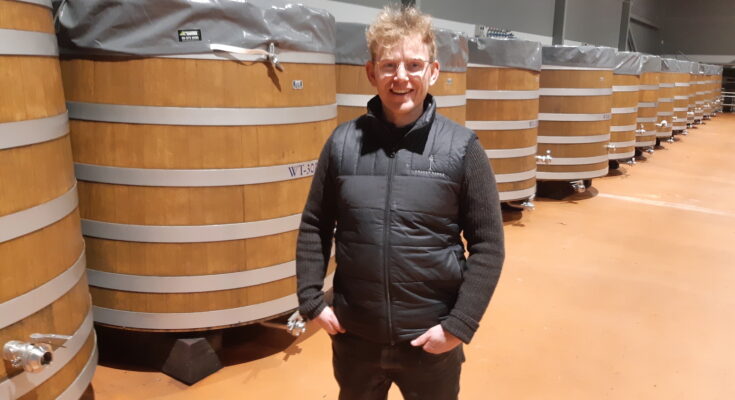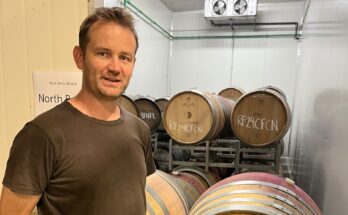I’m in Hawke’s Bay to chat to winemaker at Craggy Range – Ben Tombs. He won the 2020 Tonnellerie de Mercurey New Zealand Young Winemaker of the Year when he was working at Peregrine in Central Otago; and now works alongside the talented Julian Grounds at this iconic Hawke’s Bay label. People who would have only visited the gorgeous Giants Winery at Waimarama Road, might not realise just how big and functional this venue (where the wines are made) is – in the Gimblett Gravels.
Ben Tombs: This is the heart of us here. Every wine is finished here at the Gimblett facility, whereas the one over at Waimarama Road is for our Bordeaux fermentation and elevage. But we bring the wines back here to finish off. We’ll be beginning the rack and return of the ’21 Bordeaux next week actually. So the whole team will head down the road and be there for the week.
WineFolio: You don’t realise just how big you are — thinking of Craggy Range as a boutique operation, making gorgeous little parcels of things… but the facility here is big. And I guess people don’t even think about Craggy Range and Sauvignon Blanc, for example? Even though it is really good.
BT: It sort of sits at that high level. You’ve got the likes of Cloudy Bay and us. For the volume, it is us sitting head and shoulders above the next — at $29 a bottle, it is a big leap. This is a big facility but a lot of it is down to a lot of micro-ferments. We like to keep things small at the same time — there’s a level of complexity involved.
For Sauvignon Blanc – the grapes arrive, having been machine-picked — for the majority. The trucks back up over there and dump into the receival bin. Then the two presses — closed, inert presses for the Sauvignon Blanc. For the Chardonnay and reds we have some open-slotted presses. About 10% will be hand-picked and then barrel-fermented in puncheon, or foudres. We got just over 1300 tonne from Te Muna Road last year — a fairly decent whack. We focus on Martinborough now — that’s our identity.
WF: I was fairly surprised that you were putting more Sauvignon Blanc in the ground there. I just thought it would be Pinot.
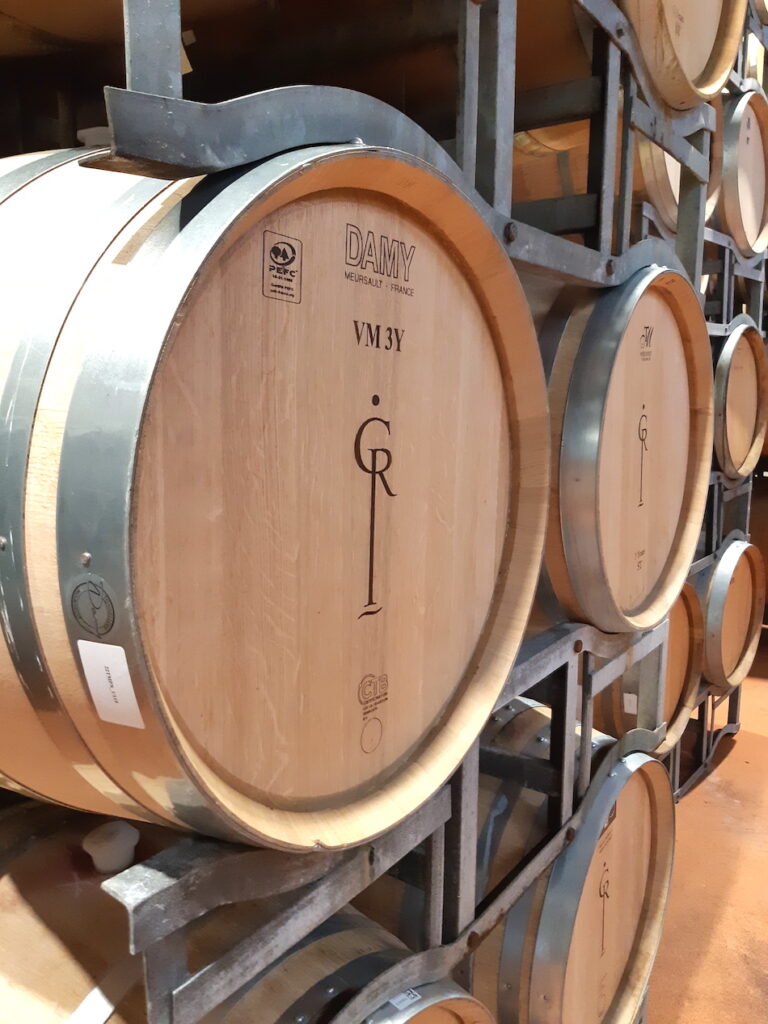
BT: there’s so much demand for Sauvignon Blanc. The thirst for it over in the States. At Te Muna you’ve got these two terraces, and one is on the flat which is a bit more gravelly and is suited for the like of Sauvignon Blanc. The terrace above holds a little bit more clay, with some flakes of limestone as well. So that’s your Pinot Noir spot.
WF: We’re here doing a big Chardonnay tasting, and we’re nuts for it; so we always think people should be planting Chardonnay when we hear about new plantings. I see Butterworth are putting Chardonnay in!
BT: The focus for us, for Chardonnay, is still here in Hawke’s Bay. It’s a much better window for ripening. We love a lot of the Chardonnay here on the Gravels.
WF: I do like Martinborough Sauvignon Blanc as well though. Not just the Craggy range one, but Palliser have always made lovely Savs from there, for example. What’s the key to it down there — is it the clones, the viticulture?
BT: The difference to Marlborough is just that in Martinborough it is much less thiol-driven, so you get a lot less of those grassy characteristics. You have the presence, the salinity and freshness you get from Martinborough. We do treat some portions in quite an oxidative style, which doesn’t bode well for thiols either. A much bigger focus on texture and salinity rather than a big fruit bomb.
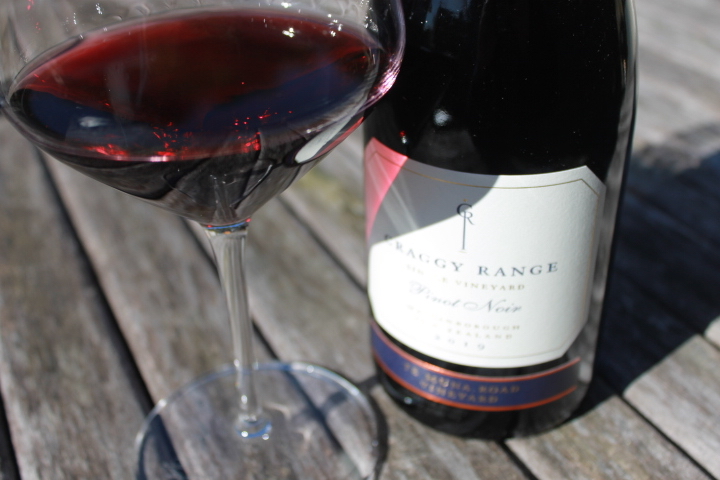
WF: We were talking last night, and I don’t think anyone was listening to what I said, but I did say that I like French Sauvignon Blanc! And I know that Marlborough is a big deal — and I like that too! But I struggle to put the two together, side by side. So how much do American consumers love Craggy Range Sauvignon Blanc then, compared to Cloudy Bay? Do they see the difference?
BT: That’s a great question, and I’m sure they do. I can’t speak volumes to that side of things. Martinborough Sauvignon Blanc is still in its infancy stage, so the more that the consumer gets educated, the more traction it will get.
WF: Well, if it gets their attention, then that’s something. And maybe they will realise that New Zealand also makes other things really well too — like New Zealand Syrah, as an example.
What led you into winemaking?
BT: I’m from Marlborough, so was amongst it anyway. After school I did some vintages with Wither Hills – Ben Glover was there then. Then off to Hawke’s Bay for study and I’ve only joined Craggy last year. I was at Peregrine for four years before that. I love Pinot and Syrah.
We move into the winery…
BT: This is the ‘red processing area’ — where the hand-picked stuff will come in, and will hold into the fruit chiller overnight if it comes from Martinborough. If it is picked off the Gravels here we’ll just process straightaway. The fruit is in 10 kilo crates and on that journey up, that is key. You could chuck it in a truck and bring it up, but it just turns into soup. It keeps things pretty small and labour intensive but it makes a huge difference.
We’ll have a hand-sorting line here, with four or five people on that. Whether or not it goes back into the crates or it is de-stemmed, depends on the style we’re going for, for that block. We like to split every block up, and we’ve got over 65 block in Te Muna now. And in the Gravels there is over thirty — and the Kidnappers and Giants vineyards as well. It’s a lot of ferments. Back in 2019 we had over 40 different cuves just for Pinot. We follow that all the way through to elevage, keeping it separate all the way up to blending. We’re getting another ten cuves in for the ’23 vintage and extending this red area out.
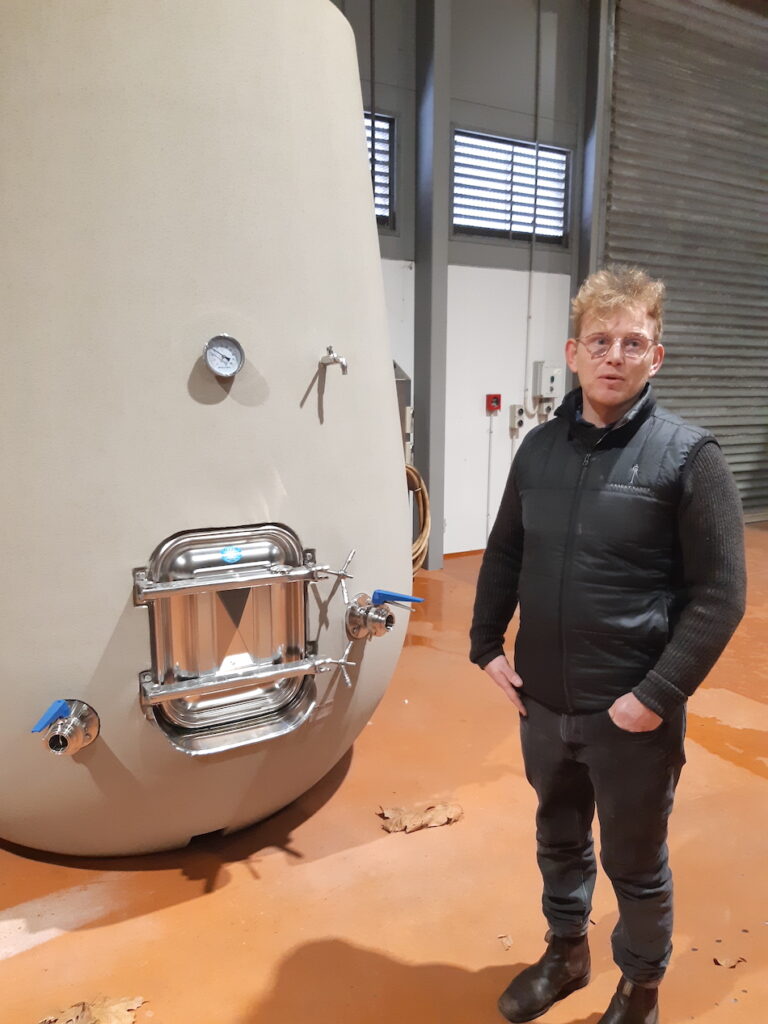
The oak and tannin elements is pretty minimal with these ones. Compared to stainless you get these erratic temperature curves, and there’s quite a wide ullage at the tops, so it is an oxidative way to handle it. At the start we’ll wrap it up — then fermentation — lids off and then wrap it over again. Also at the start we do pump-overs and keep it gentle. We put a lot of effort into retaining whole berry, so we don’t want to go breaking that up at the start. Once the fermentation is off we pick up the plungers as well — then back to just pump-overs or leaving it be.
WF: Does each ferment get treated specifically to how you want to treat that block? Do you do whole bunch in a couple, but not in others?
BT: Exactly. Following it back to the vineyard, there’s a couple of blocks and clones that we identify that bode well with whole bunch. Whereas some of the young vines at the moment, it is much better just to de-stem. We’ve also got these open tops as well, and we put Syrah in here. We’re constantly evolving and innovating, so we’ve got these 4000 hectolitre concrete fermenters as well.
WF: What difference does that bring to the equation?
BT: This just brings another dimension to it. Its a steady fermentation with these concrete vats that works well with Syrah and Bordeaux. Pinot Noir not so much. That likes a bit of heat. These won’t get as hot. The ability to hold Syrah and Bordeaux a bit longer in these is better. You can also get into problems if you have to move things too much, and all of a sudden your extraction gets out of whack. With these it’s not going to get too hot, not too cold, and you don’t have to move it. These are porous as well, being cement, so you do get some oxygen ingression, but the majority of that comes in from the top to be honest. I love the texture, and the evolution of tannins is really early with these as well. You’ve got this really nice line of quite elegant tannin, early on — compared to barrel. This is mostly Syrah and Bordeaux in here, but why don’t we go and look at Chardonnay, since it’s your interest?
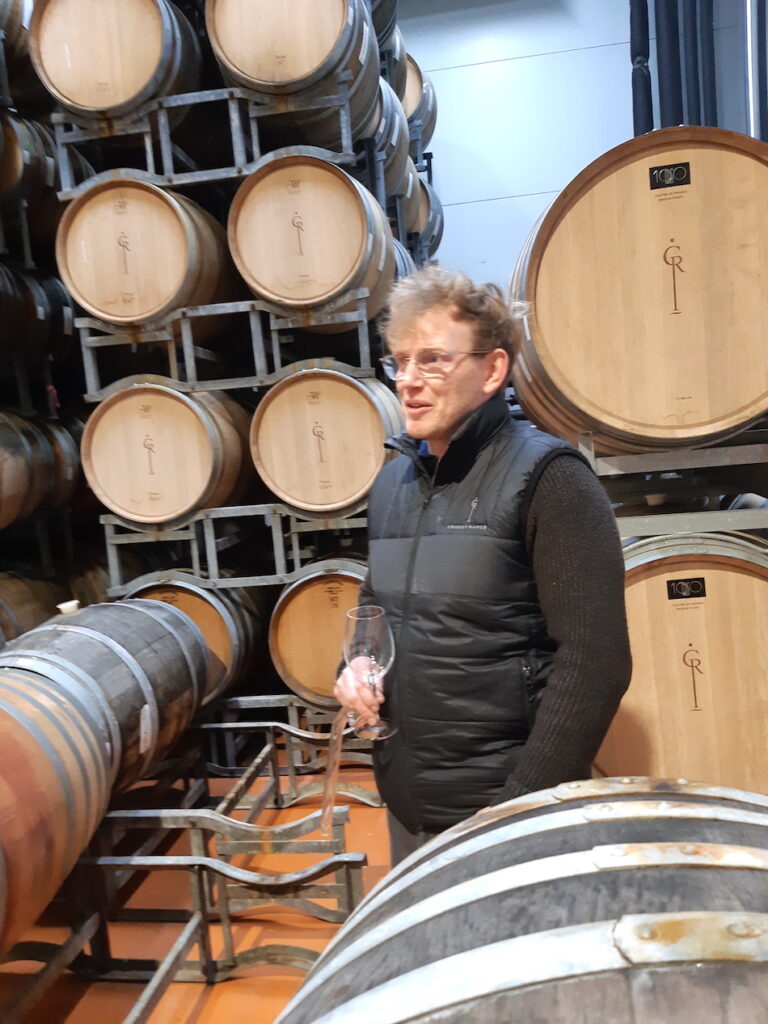
WF: Go on, twist my arm. Do you get to do a bit of everything, or are you specialising in one thing?
BT: Julian runs the show, and he’s a very busy man. Then there’s myself as the Winemaker – more implementing the vision I guess… and then there’s Luke who is the Winery Manager. We’ll then have about twenty people over harvest, so it is a decent sized crew. It is quite labour intensive. Luckily we’re surrounded by vineyards, so I also get to go out into the vineyards, and I try to make it down to Martinborough as much as I can.
WF: What part of the year do you get the most joy from?
BT: I like the start and the end. You see the fruit for the first time — other than in the vineyard — and then at the end when you’re pressing off reds and you finally get to try the wine as itself. But at the start you’ve got this amazing atmosphere with all your international interns and a really good energy and vibe. At the end it’s a good celebration that all that hard work has paid off.
This is the white fermentation area and where we do the finishing and blending. It’s pretty chokka these days, so we’re building another one, at the back there, where the warehousing is. To cope with the growth of Pinot Noir and Sauvignon Blanc really. We also got some new Stockinger Foudres this year – Austrian oak with a very light toast. They only do one toast and it is a very long, light one. Often water-bent now as well.
There seems to be a trend in Australia now, of heading back to some bigger wine styles. We do have a lot of parcels of Chardonnay now, so we get to play around a lot — like how much sulphur we’re putting in at the start of fermentation. I’ve got a Chardonnay in barrel I can show you, but it is in new oak — you OK with that?
WF: Oh yeah — bottle it!
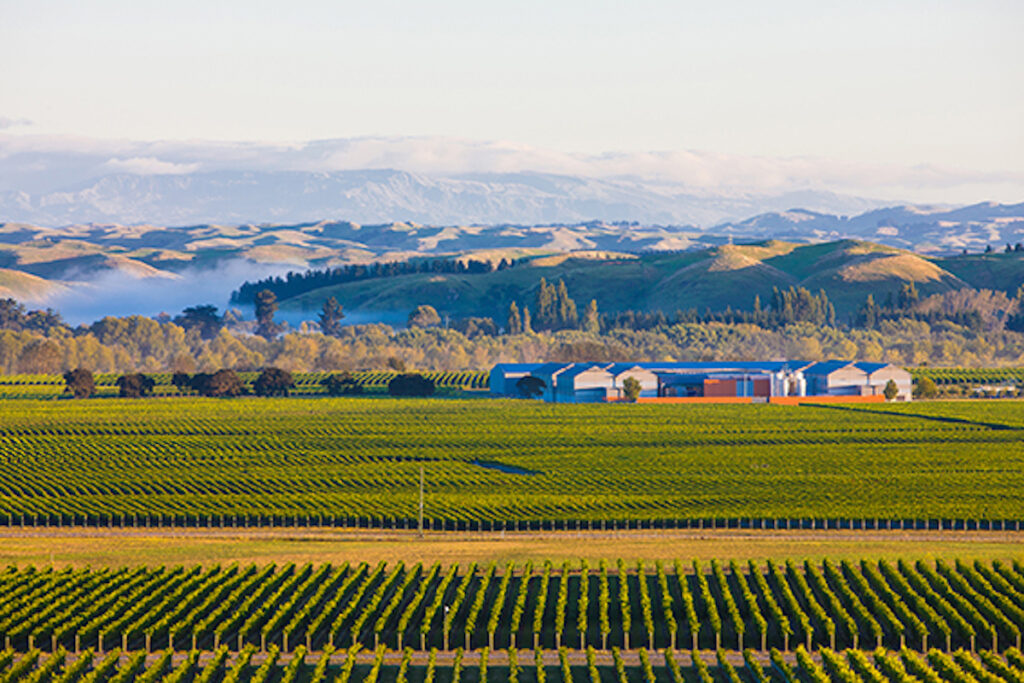
BT: This is Mendoza from Block 34 out the back there. This is a foot-stomped trial. We do them side-by-side when processing. So typically we just do whole bunch, into the press, overnight settle, then into barrel and wild fermentation. Whereas here the foot-stomping gets a tiny bit more goodness out of the skins.
WF: This has a real electricity to it, and a lovely dry, almost bitter edge to it.
BT: We’re also picking a lot earlier now. Into mid February rather than mid March, which is a big style shift. A lot of that has come from Julian. He loves the natural acidity of Chardonnay and the prettiness and elegance of something that is not huge. And using very light toasting on the barrels. We’ll do two passes of picks through the vineyard — one for the dips and one for the ridges, which can be a metre higher and get a lot riper.
So this one is Block 19 – but the dips. And we added last years lees to the juice — only 5%, and we’re intrigued to see what that gives in terms of complexity. It’s looking quite Jura-esque at the moment. It’s given a lovely weight to the wine. Hard to tell really, with it pre-malo. The way the texture from the less envelops that acidity. You’ve still got that beautiful drive, but you’ve got a weight to it. You have to do these things in order to learn and keep on with evolution. We have a couple of elevage trials as well where we hold for another year in barrel.
It will be interesting to see how it comes together. Same with some of the Pinot and Syrah as well. They’ve been in barrel for twelve months and come out to blend, and having a look at how that evolution of tannin is really performing. Has that amalgamated with the texture and become one? That’s always an exciting process to be a part of — and it is a huge call. Is it ready, or does it go back to barrel or tanks for another few months?
WF: You sound like you’re really loving it here?!
BT: It’s like being a kid in a candy store with all these trials. It’s fantastic. And you have the resource and the ability to do these sort of things.
WF: Is there anything else you’d like to have a go at making?
BT: Honestly, probably not. Syrah, Pinot and Chardonnay is my passion. I wouldn’t want to dilute it further than that. I want to help evolve those rather than do a big breadth of different wines. There’s enough here you can really dial in on.
WF: With something like Les Beaux Cailloux – there’s a clear shift in the style of the wine, from 2018 through ’19 and ’20. Now, I know that is down to a change in the vineyard — and perhaps the earlier picking regime. But what there is a consumer who doesn’t want to see that change? Who doesn’t want to see vintage variation, never mind a change in style development?
BT: The shift has been to the style. A bit more precision and elegance rather than something that is big, charry and rich. Also, our Chardonnay was fantastic this year — in 2022. We have quite a ripe site and we’re picking mid-February, and it was off before those big nasty rain events. A week later we were hit pretty hard. The Merlots look pretty strong too. It was a pretty warm Spring then a warm Summer, so they look sharp.
WF: The forgotten fruit!! Honestly, no-one talks about it. Good Hawke’s Bay Merlot is just wonderful. I do love Syrah though, hahaha. I know Le Sol is many people’s favourite Syrah.
BT: Yes, that’s iconic. It’s what put us on the map – Le Sol. Aroha and Le Sol are the two for me. Aroha is a pretty iconic Te Muna Pinot as well. It’s hard for New Zealand Syrah when there is so little of it. And you compare that to somewhere like Australia where they are able to produce $20-30 dollar bottles of Syrah with a fruit sweetness that we can’t get. We have to crop low and put a lot of energy into it, and then not every producer can afford to do that.

